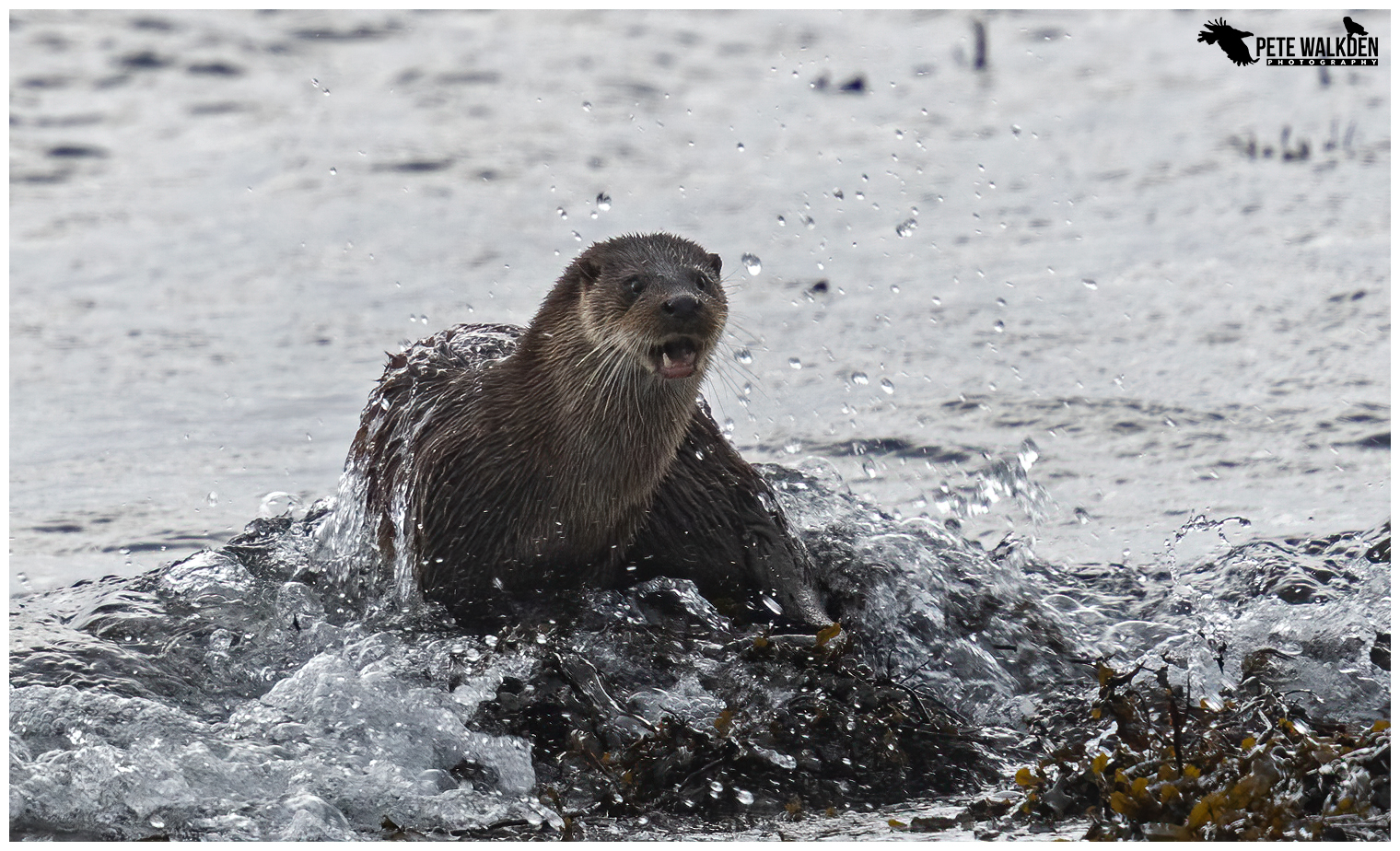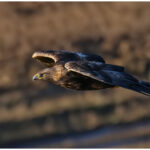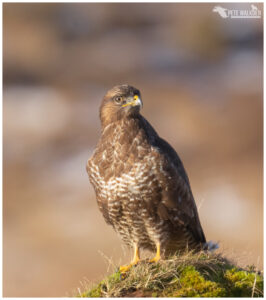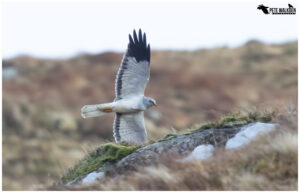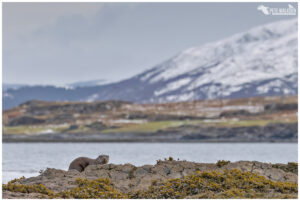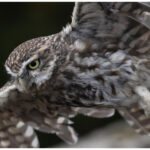
Going Mirrorless – Canon EOS R5
28th September 2020
Kite APC Stabilized Binoculars
18th June 2024Canon R7 Review
Introduction
Anyone familiar with my website and the equipment I use will know that since late summer of 2020, my camera of choice has been the Canon R5. I have only used this camera body since buying it, and it is in my opinion the best camera I’ve ever had the pleasure of using.
So why have I invested in another camera, the Canon R7?
I live in the Highlands Of Scotland running Wildlife Photography Workshops (Inverness) and both workshops and Otter Photography Tours on the Isle Of Mull, and the weather is challenging at times.
My R5 has had to put up with some pretty heavy showers, and despite it being somewhat protected with canvas rain-covers, it has got wet, and last year one of the main dials on the camera stopped working for a few days while it dried out. That worried me, as I didn’t have a backup camera other than my old 1DX which feels ancient in comparison.
I considered perhaps another R5, or maybe investing in the more expensive R3, though that would surely have become my primary body, certainly on wet days. But it lacks a decent mega-pixel (MP) count so aside from the slightly improved and faster auto-focus (AF), and weather-sealed body, it didn’t appeal too much to me.
Around this time, Canon announced two new camera bodies, both mirror-less. The R10 and the R7. The latter did appeal on many levels. I have always had a cropped-sensor camera in my arsenal and this one features the same AF system as the R3 has, plus a 32MP sensor. And it is relatively inexpensive.
So I contacted a friend who works at The Flash Centre, and he kindly sourced a brand new Canon R7 for me.
Features
As mentioned above, the R7 is a cropped sensor camera, which effectively adds a 1.6 crop factor to all lenses, making my RF100-500mm lens into a 160-800mm lens, which is light enough to be slung over one shoulder during long hikes over the hills.
On my EF500mm lens, usually coupled with a 1.4TC, this gives me 1120mm reach now.
And for wildlife photography, additional reach is never a bad thing. It makes subjects larger in the electronic viewfinder (EVF) which allows the fancy subject-tracking AF to work more accurately, in theory retaining a better focus-lock on subjects.
With 32MP, the images from the R7 are more detailed than from the “cropped-mode” on my R5, which is only 18MP. I’ve compared images of a subject using both cameras and the R7 is noticeably sharper at the same effective level of cropping.
It also uses the same batteries as my R5, so I can swap them between both cameras. You will need spare batteries though. I can get a day’s worth of images out of one battery, but I always carry spares.
- ISO 1000, 1/500th, f/7.1, 500mm (RF100-500mm)
- ISO 1250, 1/800th, f/7.1, 500mm (RF100-500mm)
Ergonomics
The R7 is a small camera body and Canon have no plans for a grip, so there is no option for a larger footprint. I have small hands, but I do still get pains in my hand when holding the R7 when it is attached to the larger 500mm prime lens, as I did with the R5 before buying the grip.
It also lacks the three dials that the R5 has, so changing the three main settings (ISO, aperture and shutter speed) isn’t simple with just one hand in full manual mode, though it can be done using Fv mode. If an RF lens is attached, then the programmable ring on the lens can be set for whichever setting isn’t active on the camera itself.
The buttons at the rear that I have configured for focusing are quite far apart, so it can be a bit awkward to find the one closest to the shutter button, especially if you’re wearing gloves.
But I’m being picky here. And I’m comparing it to the R5 which most people won’t be, if they just go for an R7.
EVF
As with the R5, you’re looking at a screen through the viewfinder, but unlike the more expensive body, the screen is obviously that, a screen. It lacks the resolution of the 4K one in the R5 and can appear a little pixelated at times. But it’s good enough for use and if you don’t own a more expensive camera, it won’t be noticeable.
The layout of the screen can be set as desired with as much or as little information showing on it.
There’s a slight stuttering appearance when firing off bursts of images at say a fast moving object, but it is something that I have got used to.
- ISO 640, 1/2500th, f/6.3, 700mm (EF 500mm + 1.4TC)
- ISO 640, 1/1250th, f/7.1, 500mm (RF100-500mm)
LCD Screen
I rarely use the screen on the rear of either camera. If I’m reviewing images, I tend to look at the EVF screen, but the R7 one is sharp, and controlled via the buttons or your fingers. And can be folded in, so it’s protected and switched off, thus saving valuable battery power.
Memory Cards
The R7 has two SD card slots. After some research online, I bought a Kingston 128GB Canvas React Plus card, and it seems to work well. Certainly doesn’t seem to take too long to save shots to it.
A benefit over the R5 as these memory cards are significantly less expensive than the CF Express ones needed for that.
- ISO 2000, 1/400th, f/6.3, 700mm (EF 500mm + 1.4TC)
- ISO 1250, 1/500th, f/6.3, 700mm (EF 500mm + 1.4TC)
Images And Performance
I could waffle on for ages about the features on the camera, but what really matters is how it performs, and the quality of the images it captures.
I like to use a product for a while before writing a review on it, which is why I’ve been pretty much solely using the R7 since buying it, for my own photography days and during workshops with clients.
Let’s cut to the chase. The combination of the R7 with the RF100-500mm lens is, for wildlife, absolutely brilliant. To have up to 800mm reach in such a portable format is fantastic for long walks or scrambling over rocks, when a much larger, unwieldy prime lens would get in the way.
I already loved the RF100-500mm for its flexibility and clarity when coupled with the R5, so effectively extending the reach of it with the R7 is making a superb all round lens even better.
The AF in the R7 is also superb and more flexible than that of the R5. Personally I’m not convinced that it is as accurate or reliable as the R5, but comparing it to say the old 7D mk2, it’s in a different league.
Whilst walking over the local hills recently, I spotted a golden eagle perched on a distant hillside. When the eagle took flight, the R7 locked on and tracked it as it flew against hills, trees, fields, the sky and the sea, and I captured arguably my best ever images of this magnificent raptor.
- ISO 800, 1/2000th, f/7.1, 472mm (RF100-500mm)
- ISO 800, 1/2000th, f/7.1, 472mm (RF100-500mm)
- ISO 800, 1/2000th, f/7.1, 472mm (RF100-500mm)
- ISO 800, 1/2000th, f/7.1, 472mm (RF100-500mm)
As with the R5, the AF doesn’t seem to be able consistently lock on to the eyes of otters, or any animal reliably. But it does focus on the body or the head, and that’s usually good enough.
ISO values can be pushed fairly high too, especially when ETTR is employed, and that coupled with the latest RAW-processing software such as Topaz and DXO, cleans any noise from such images perfectly. Even Lightroom can be used to remove most of the noise using certain post-processing methods.
Buffering
My initial concerns with the R7 came from the small buffer on it. My R5 can shoot over 200 images before it buffers. That’s 10 seconds worth at 20fps on electronic shutter mode (which I use mostly).
The R7 has a buffer of 30 images when using full RAW files and on electronic shutter mode, it takes 30fps… oh dear, a 1 second buffer isn’t much good for wildlife action.
However, this can be adjusted and managed far more effectively.
If the frame rate is reduced down to 15fps, which is enough believe me, to capture most action going on, and instead of full-fat RAW, the C-RAW (trust me, this is indistinguishable from the full RAW file in terms of image quality) mode is used instead, then you’re looking at several seconds of a buffer, and if you train yourself to limit the bursts of images taken, then it won’t buffer.
A fast card helps too, hence the choice above.
So buffering for me isn’t an issue.
Image Quality
With 32MP to play with, detail levels are good and so is sharpness.
Rolling shutter is apparent when reviewing images from a burst though, and subjects can appear to change shape. With stills this isn’t so apparent in isolation, but it can manifest itself when recording videos.
- ISO 1600, 1/400th, f/6.3, 700mm (EF 500mm + 1.4TC)
- ISO 1600, 1/500th, f/7.1, 500mm (RF100-500mm)
- ISO 500, 1/125th, f/6.3, 700mm (EF 500mm + 1.4TC)
Auto Focus
The R7 offers a more flexible AF system than the R5, with user-defined zones and additional subject tracking, not even an option on the R5. This means in some situations the R7 should provide better auto-focusing than the R5, and I’m sure this is the case, if I had four arms and could shoot them side-by-side. I’m really looking forward to trying it out on fast subjects like puffins and swallows, to see how it compares.
For the price of the camera, the AF it offers is nothing short of phenomenal. It is effectively the same as that is on the R3. It tracks the eyes of subjects, and remains locked on to things like birds in flight, regardless of what the bird is flying past.
If you’re trying this camera having come from a similarly priced DSLR, you’ll be blown away by the AF system and your hit-rate will go through the roof.
However, if like me, you have an R5 (probably the same for the R3) then you’ll notice that the focus isn’t quite so reliable in comparison. The R5 is so good, and so accurate at focusing and retaining the focus, that I have begun to assume all images within a burst of shots will be in focus, provided the focus is achieved in the first instance.
But I’m finding that in a similar burst from the R7 this isn’t the case, and some images won’t be quite in focus. This makes the task of reviewing images and selecting the best one to use, more time-consuming.
It does hit more than it misses though, and I think the lens being used affects this too. In my experience, the R7 seems to work better with RF lenses than the old EF ones, whereas the R5 seems to work brilliantly on both.
Update (July 2023):
I need to add a couple of points here, after using this camera for months. Firstly the focusing has an issue. It's not a deal-breaker, but it will affect your images from time to time. For some reason, the accuracy of the focusing fluctuates between images. It is most apparent when photographing a stationary subject. From a burst of say ten images, most should be fine, but here and there, the focus simply moves off of the subject, and the image is soft. Generally this doesn't matter, as the camera takes so many shots per burst, you're highly likely to get a sharp one in there, but it is really annoying.
When compared with the R5, I find that in a burst from that camera, finding one that is out of focus is a challenge, if the focus lock was obtained initially.
And I'm not alone with seeing this, as some YouTube channels have reported the same issue.
The second issue is rolling shutter, and it is more apparent in this camera than on the R5. It is particularly noticeable when using the pre-burst function that takes images before you press the shutter release button. I was photographing swallows taking off, and some of the shots had the swallows with S-shaped wings, clearly showing the lag from rolling shutter. Which is annoying because it affects the sort of images you're trying to capture with such a cool feature. It can be minimised somewhat by zooming out, or moving back from the subject, and then cropping in on the final image.
Panning images also shows it, especially if there are vertical structures behind the subject, such as trees or buildings.
Finally, the overall image can appear stretched or warped when scanning through a burst of images. In isolation it wouldn't be noticeable but when looking at a series of images of the same subject, it is clear to see.
- ISO 640, 1/1250th, f/6.3, 700mm (EF 500mm + 1.4TC)
- ISO 400, 1/1600th, f/6.3, 700mm (EF 500mm + 1.4TC)
- ISO 1000, 1/800th, f/7.1, 500mm (RF100-500mm)
Pre-Burst Capture
This feature is pretty much what Olympus calls Pro-Capture, albeit less well implemented here. Canon's version is similar but lacks options and is a bit clunky in how it all works.
When activated, the camera will record images when the shutter release button is half-pressed. On the viewfinder there's a vertical display of images in the buffer, and this fills rapidly when the shutter is fully pressed, and the camera then sits for a while to clear the buffer, create the file for viewing, and then be ready for shooting again.
Once you're used to how it works, it can be very handy. I have used it for capturing swallows taking off and also flying through a window of a barn. Impossible without some sort of Ninja reaction, which I definitely haven't got in my arsenal!
The files it creates seem to be some form of zip perhaps, that are readable to only the camera or Canon's own DPP software. Personally, I review in the camera, and extract any that look interesting in RAW form, then delete the original file, as they're huge files.
It should also be noted that when using this feature, because the camera is taking images constantly, it uses the battery quickly.
But overall it's a great feature and one that I'm surprised isn't on the R5 for example.
Things I Like About The R7
The additional reach, as mentioned. It does make a difference, especially for wildlife. Now I can reach for the R7 in situations where I know the R5 might struggle to focus on something that is too far away, or I want a bit more detail if I’m going to have to crop in.
It’s light too. I know I can remove the grip from the R5, but that’s a bit of a faff. Having a lightweight combination for long walks, or for guiding is so helpful.
I also like the ability to change the frame rate for the electronic shutter. I wish the R5 had it, as that is 20fps or 1.
When I bought the R5 the idea of having a silent camera was really appealing, and it still is. However, also having the option to have a fake shutter sound made is brilliant, as you know you’re taking shots. It’s quiet enough for me to hear but not the subject. That said, the clicking doesn’t seem to relate to the number of images actually being taken, so sometimes I think I’ve taken loads in a burst only to find it’s only taken one or two.
The easy-to-activate video option, with a simple click of a switch. The R5 needs a couple of buttons to be pressed to get it to activate, which can mean missing the action.
Things I Don’t Like About The R7
The missing dial. I shoot manual and having tactile clicking dials on the R5 make it so easy to change the three settings with just one hand, without taking my eye away from the camera. I know I can use Fv mode, and I might go back to that. I’ve mainly been using M mode and leaving the aperture as the setting I don’t change.
The back-buttons are too far apart, and I do occasionally find myself feeling around the back of the camera to select the furthest right one.
The lack of the top LCD panel for viewing settings, but hey, it’s a fraction of the cost of the R5, so it can’t offer such features.
The mode dial on the top could do with a locking feature as it can be knocked round by accident. The old 7D mk2 had a little button that needed to be pushed before the dial could be turned.
The back dial (around the joystick) can't be customised for ISO. I've changed the button functions so the ISO button is now the top of the four buttons that make up the circle control on the back of the camera, as it's easier to find with my thumb than the marked button on the top. So now I press that and can use the dial on the back to adjust the ISO. It's a shame it can't just be set for ISO, as it allows Aperture Control, but not ISO.
Rolling shutter and fluctuations with the focusing. See above.
- ISO 2000, 1/1000th, f/6.3, 700mm (EF 500mm + 1.4TC)
- ISO 1600, 1/1250th, f/6.3, 700mm (EF 500mm + 1.4TC)
Yet To Test
In-camera focus stacking. This should be fun on insects during the warmer months. I’ve done hand-held focus stacking before (thanks to some tuition from Oliver Wright), and processed the images in Lightroom and merged / aligned in Photoshop. But this does it all for you in the camera, in a few seconds. I’m looking forward to trying this out.
- ISO 2000, 1/1600th, f/7.1, 254mm (RF100-500mm)
- ISO 2000, 1/1000th, f/7.1, 500mm (RF100-500mm)
- ISO 2000, 1/1000th, f/7.1, 500mm (RF100-500mm)
Conclusion And Verdict
I’m still learning the ways of the R7, but the more I use it, the more I like it. I don’t regret for a moment investing in it, nor do I regret taking it out instead of the R5 over the last month or so.
I’ve captured some amazing images with it, some of which I don’t think I could have with the R5, simply from the lack of reach with that full-frame sensor. That said, I’ve missed some too, simply because my fingers aren’t trained fully to press the correct buttons. That’s the downside of having two cameras with differently positioned functions.
Sure, it lacks some of the finesse of the R5, the images don’t have that incredible detail available from the 45MP on that full frame sensor, and it lacks some functionality too.
But for what it is, for the price point, for what it can give to someone interested in capturing images of wildlife, it’s nothing short of fantastic. Coming from an old DSLR to the R7 is quite a step, but once you see what the camera and that AF system is capable of, especially when coupled with a lens like the magnificent RF100-500mm, there’s no going back.
The irony for me here is that I bought the R7 instead of the more expensive R3 to avoid having a conflict of what camera to take out daily. But the R7 has proved its worth so much, that I have that dilemma now anyway!







